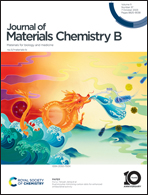A hydrogel gripper enabling fine movement based on spatiotemporal mineralization†
Abstract
Fine tailoring of the subtle movements of a hydrogel actuator through simple methods has widespread application prospects in wearable electronics, bionic robots and biomedical engineering. However, to the best of our knowledge, this challenge is not yet completed. Inspired by the diffusion-reaction process in nature, a hydrogel gripper with the capability of fine movement was successfully prepared based on the spatiotemporal fabrication of the polypyrrole (PPY) pattern in a poly (N-isopropylacrylamide) (PNIPAM) hydrogel. The hydrogel was given gradient porous structures using a one-step UV irradiation method. Moreover, photothermal PPY patterns on the hydrogel were obtained through spatiotemporal mineralization of ferric hydroxide followed by the polymerization of pyrrole in a controllable manner. Taking advantage of the unique structures, the hydrogel gripper can not only achieve reversible grasping–releasing of substrates with the tuning of temperature (similar to that of hands), but also generate delicate movement under the irradiation of light (resembling that of finger joints). The strategy reported here is easily accessible and there is no need for sophisticated templates, therefore making it superior to other existing methods. We believe this work will provide references for the design and application of more advanced soft actuators.



 Please wait while we load your content...
Please wait while we load your content...